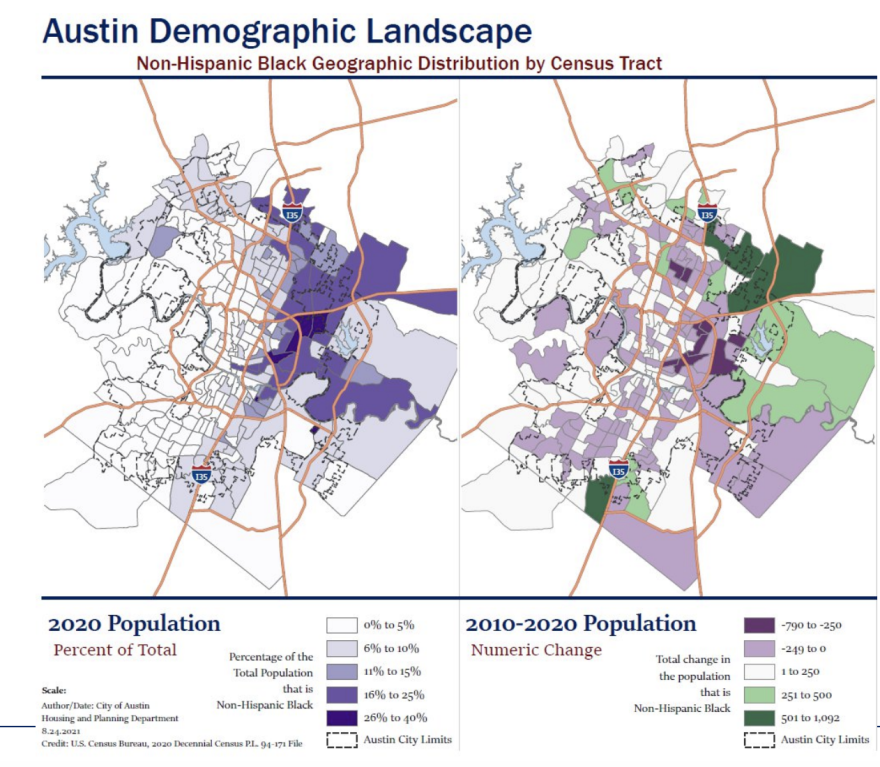As the share of Austin’s residents who identify as Hispanic or Black decreased over the past decade, city staff and elected officials wondered this week what to make of this pattern.
“How much of this is displacement, where people are moving farther and farther east or out of the city altogether, and how much of this is an undercount?” Lila Valencia, the City of Austin's demographer, said during a City Council meeting Tuesday.
What Valencia could definitively say is that racial segregation has continued in Austin over the past decade. In a presentation of preliminary 2020 Census data to Austin’s council members, Valencia showed how residents, particularly Black and Hispanic residents, have continued to move east.
The population of Black residents grew on the outskirts of the city. This includes in Northeast Austin, on the edge of Pflugerville, and far East Austin.

At the same time, white residents are increasingly living in historically Black and Hispanic communities, like East Austin, while still maintaining a large share of the population of West Austin.
“There’s a continued geographic segregation among our city’s different racial communities,” Valencia said. “There also is a concurrent farther eastward movement of the population with increasingly higher shares of the non-Hispanic white population in the historically Black and brown neighborhoods.”

While Austin’s population grew by about 22% over the past decade, much of that was fueled by the growth of white residents. The reverse was true across Texas and the nation, where people of color drove much of the population increase.
In 2010, Hispanic Austinites made up 35.1% of the total population; in 2020, that portion fell to 32.5% of the population.
The same pattern occurred among Black Austinites, whose share of the population fell by about 1% in the past decade to 6.9%.
“While Austin is a growing city, we’re also experiencing a displacement crisis,” said Council Member Vanessa Fuentes, who represents a majority-Hispanic district in Southeast Austin.
Council Member Pio Renteria, who represents parts of East Austin, blamed the changing racial patterns on a lack of housing, particularly for low-income residents.
“This is a prime example of our failure not to build enough housing, especially enough affordable housing,” he said.
Valencia noted that the rate of housing construction in Austin slowed in the past decade. Between 2010 and 2020, the number of housing units grew by 25.5%, down from a rate of about 28% in the decade prior.

“Given the city’s long trends of strong and sustained growth, it’s imperative that housing growth is able to continue to keep pace with population growth,” Valencia said.
Other council members cautioned that this data was only preliminary and that the city should wait to draw any major conclusions from it.
“I do want to underscore that the data that we have at this point in time is very incomplete, and when we get the fuller data set, we’ll be able to do a lot more analysis that will give us more information about how our policies are working and how they’re not,” said Council Member Alison Alter, who represents a part of West Austin.
"continued" - Google News
September 30, 2021 at 05:03AM
https://ift.tt/3umHXI6
Austin's Racial Segregation Continued Over The Last Decade, New Census Data Shows - KUT
"continued" - Google News
https://ift.tt/2WiTaZN
https://ift.tt/2YquBwx
Bagikan Berita Ini














0 Response to "Austin's Racial Segregation Continued Over The Last Decade, New Census Data Shows - KUT"
Post a Comment